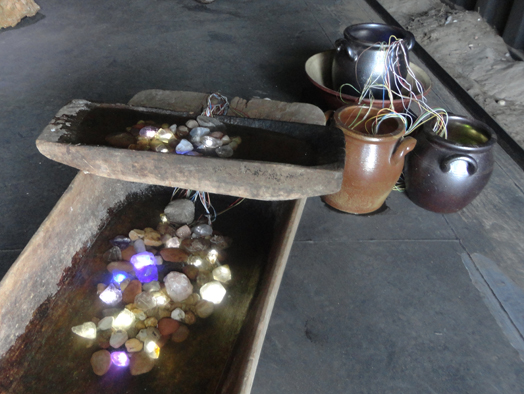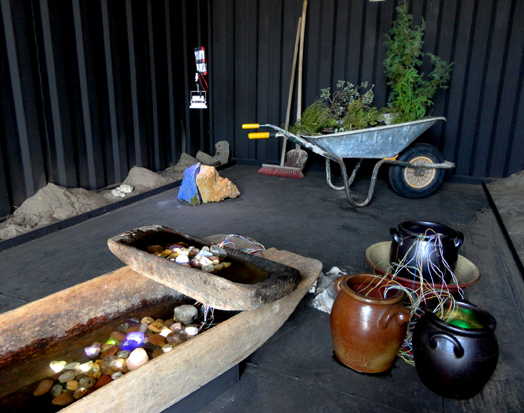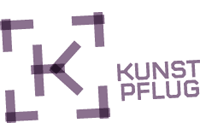PETER OJSTERSEK
”QUARTZ DE LUX”
Quarz Kristalle, Computer programmierte LED-Leuchten und Wasser, arktische Pflanzen, Artefakte
 Ausgangspunkt für Peter Ojsteseks Installation “Quartz de Luxe” ist eine Sammlung von Artefakten, die er von einer Reise auf den landschaftlichen Spuren des Eises vom Polarkreis in Skandinavien bis zum Baruther Urstromtal nach Baitz mitgebracht hat: Quarzkristalle mit LED-Leuchten, arktische Pflanzen, Gebrauchsgegenstände aus Keramik und Holz, Wasser, Sand, Steine und gegossene Betonformen.
Ausgangspunkt für Peter Ojsteseks Installation “Quartz de Luxe” ist eine Sammlung von Artefakten, die er von einer Reise auf den landschaftlichen Spuren des Eises vom Polarkreis in Skandinavien bis zum Baruther Urstromtal nach Baitz mitgebracht hat: Quarzkristalle mit LED-Leuchten, arktische Pflanzen, Gebrauchsgegenstände aus Keramik und Holz, Wasser, Sand, Steine und gegossene Betonformen.
Diese Gegenstände interagieren mit der Umgebung und werden im ERRATIKER-Container zu einer Art Diorama durch verschiedene Epochen zusammengefügt.
Quarz ist die Hauptkomponente von Sand und schuf die ersten Bedingungen für lebende Organismen. Pflanzen benötigen Sonne, Wasser und Sand um zu wachsen, was die Nahrungsvoraussetzung für grasende Tiere ist. Diese Grundlage ermöglichte die Kultur der Jäger und Sammler.
Quarz wurde durch alle Epochen hindurch zur Herstellung von Werkzeug, Glas und Baustoffen verwendet und ist heute zur Herstellung von elektronischen Gegenständen wie Uhren, Radios und Computern, sowie für Beton unerlässlich. So bin ich der Ansicht, dass wir uns von einer Holz- und Steinkultur hin zu einem Sandzeitalter bewegt haben.
Peter Ojstersek.
PETER OJSTERSEK
”QUARTZ DE LUX”
Quartz Crystals, computer programmed LED light and water, arctic plants, artefakts.

 The starting point for ”QUARTZ DE LUX” are collected artefacts which I brought with me during a journey through Sweden following the traces of the ice in the North which I brought to the Glacial Valley of Baruth: Quartz Chrystal’s with LED lights, arctic plants, ceramic pots, wooden tray, water, sand, stones and casted concrete sculptures. The installation is presented as a temporary art work in a metal container.
The starting point for ”QUARTZ DE LUX” are collected artefacts which I brought with me during a journey through Sweden following the traces of the ice in the North which I brought to the Glacial Valley of Baruth: Quartz Chrystal’s with LED lights, arctic plants, ceramic pots, wooden tray, water, sand, stones and casted concrete sculptures. The installation is presented as a temporary art work in a metal container.
My first impressions were this sandy dune landscape with the smell from resin from pine threes close to the bicycle road stretched from Calais to St Petersburg which is following the Glacial Valley of Baruth with sand formations created during the last two ice ages. When looking out over the landscape it is easy to imagine the melting water from ancient glacial river throwing out crushed Scandinavian mountains as sand and gravel. This experience must have made a strong impression on me and I didn’t know that I was going to spend the summer following and thinking about the traces from the ice through Sweden up to Torneå see and through Norway and back to Baitz.
”QUARTZ DE LUX” is the result from my journey. The collected and displayed objects and materials connect for me different parts of our cultural history after the last ice age.
In the Art project ERRATIKER in Baitz I was confronted with the overwhelming experience of sand and gravel quartz which got stuck in my mind. I began to see glimpses of the cultural history since the last ice age through the mineral quartz.
In the installation I have chosen to use quartz crystals with integrated LED light´s in an installation with quartz, plants, pottery, and wooden trays.
Quartz is a major component in sand and together with bedrock the first settlement for living organisms after the ice age.
Sunlight, water and sand are the conditions that were needed for plants to grow and to create the condition needed for the wild animals grazing.
This made it possible to create a culture from hunters and collectors.
The mineral quartz follows us through our cultural history: Quartz is used since the stone age as flint and quartz shards used for tools. In the bronze age, quartz sand and clay was mixed together for creating pots for melting bronze and later for burned bricks and glass production, today it´s used in electronic equipment as watches, radios, computers, and sonars. Quartz is today also used in all kind of construction work as concrete and production of hightech glass and ceramics.
A thought that follows me, we define our culture in categories as stone age, bronze and iron age. We now must be living in the sand age, thinking on all new megacities made from glass, concrete, metal and plastic, operated with advanced electronic systems.
During my journey along the landscape created by ice in mind I have travelled from Baitz through Sweden up to Kiruna, crossing the polar circle and driving along Torneå see over to Narvik and through Norway down to Baitz again. During the travels I have been collecting plants, rocks and the artefacts to be used later in the installation. My intention is to interact with the surrounding landscape and different time periods and use of the Container as a diorama the visitors can enter.
During my research I have noticed that during our history we have moved from a wood- and stone- to a sand culture: Quartz is central in our culture and is used for concrete, glass, ceramics and electronics and also is an important content of our soil where we grow our food.
Peter Ojstersek
